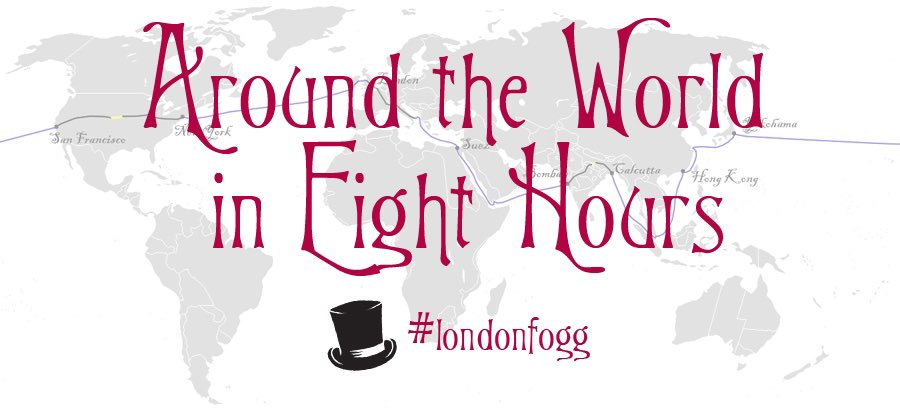
It’s 150 years this year since Jules Verne published Around the World in Eighty Days. Today I shall embark on my own voyage of homage, on foot, visiting places related in some way to every country Phileas Fogg went to. But the twist is it’s all in central London. #londonfogg 🧵 

America Square is now dominated by modern buildings but it was originally built 1768-1774 by George Dance the Younger, it seems to celebrate Britain’s colonies in America and house some of their merchants and sea captains. Banker Nathan Mayer Rothschild lived here. #londonfogg https://t.co/Bf34ed4kLj
A stone obelisk stood in its centre, at least until the 1950s. The square survived the Blitz, but a 1944 V-1 strike caused major damage and no original buildings survive. Roman walls were rediscovered during construction of 1990 office complex One America Square. #londonfogg
Sadly I couldn’t access the chunk in the basement but the office manager has kindly just taken me round the corner to this. #londonfogg https://t.co/0dUalaCWAg
And in a nearby building, this! #londonfogg https://t.co/Tg9h8Ijhck
(Verne: On arriving in San Francisco “Passepartout observed with much curiosity the wide streets, the low, evenly ranged houses, the Anglo-Saxon Gothic churches, the great docks, the palatial wooden and brick warehouses, the numerous conveyances… #londonfogg)
From America, Fogg went by steamer to Ireland, then took the train from Queenstown to Dublin. The City of London has Ireland Yard, where Shakespeare bought a house in 1613, and 9 years earlier some of the Gunpowder Plot plotters had plotted. But I’m not going there… #londonfogg
Here’s the London Stone, psychically propping up the metropolis, in a happier location now than last time I saw it years ago. #londonfogg https://t.co/mwSDR2rkvm
London has Queenstown Road and Dublin Avenue. Nope, not there either. The north London Irish community of Kilburn is too far, as is the Irish Cultural Centre in Hammersmith. Instead, my feet take me to… #londonfogg
What *claims* to be the first ever Irish pub outside Ireland. A sign used to say it was founded c.1700 by Mooney & Son at the Boar’s Head, 66 Fleet Street – and the first to serve Guinness. But the plaque outside was riddled with fictions… #londonfogg https://t.co/7nVUBr3Ltz
Now it seems the sign has gone and – I wasn’t expecting this – the pub is no more. A dusty Mooney carving marks the doorstep. So it goes. #londonfogg https://t.co/xJRmoMocoO
The site was also associated with the Bolt-in-Tun inn next door, and only became Mooney’s Irish House in 1895 & The Tipperary c.1968 (not after WW1 as claimed). An excellent article by @zythophiliac (zythophile.co.uk/2018/09/27/the…) provides the facts behind the… blarney. #londonfogg
Signs of old Fleet Street types. #londonfogg https://t.co/heMIwa7m9Z
Back to Britain. Fogg landed in Liverpool (London’s Liverpool Street & Road were actually named after early 19th C. prime minister Lord Liverpool, who had chuff all to do with the place). His train would have taken him to Euston, but the book doesn’t mention it. #londonfogg
Euston Station first opened in 1837 and was expanded in 1849. By Fogg’s time the London & North Western Railway connected Liverpool and London directly. Verne says the journey took 6 hours but Fogg ordered a special train, taking 5 and a half. Today it’s half that. #londonfogg https://t.co/q35onEuSMt
The final push, past a suitably Foggish hat shop. #londonfogg https://t.co/wLkDqEkxst
Back in London, Fogg believed he was 5 minutes late for the deadline – “having steadily traversed that long journey, overcome a hundred obstacles, braved many dangers… to fail near the goal” – so he just went home to Savile Row. #londonfogg
Having miscalculated the date, Fogg won his wager after all and hotfooted it back to the Reform Club… #londonfogg
So here I am again, after 23.3 miles of walking and 7 hours and 19minutes. So I made it! Now to Mr Fogg’s Society of Exploration (@MrFoggsGB) to celebrate! Pip pip. #londonfogg https://t.co/llke4rWXr3
PS. If you’d like to read about one of the real-life adventurers who inspired Julles Verne, my weekly history-themed newsletter is about exactly that and goes out this evening. gethistories.com @gethistories). Thanks for following! #londonfogg